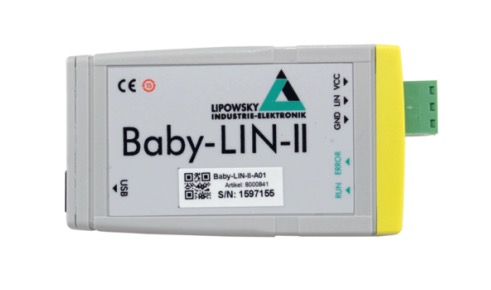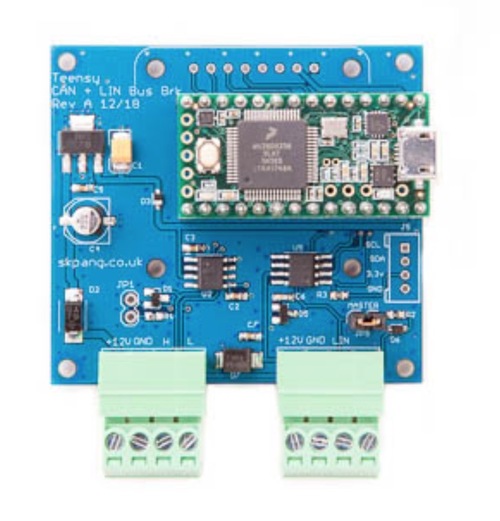Blog
Recent Posts
Gateway Device Controls LIN Bus Via USB, Simulates LIN Master Or LIN Slave Nodes
Posted by on
Lipowski Industrie-Elektronik (Germany), a member of the LIN-Consortium, offers its Baby-LIN-II gateway. The Baby-LIN-II represents a small but powerful system to control a LIN bus via USB and simulate LIN master or LIN slave nodes. The galvanically isolated LIN interface avoids problems in harsh environments.
The device also supports stand-alone operation without a PC. A durability test sequence can be set up as a macro and automatically start connecting to the LIN bus, entirely without a PC.
The Baby-LIN-II can simulate different configurations of LIN-Bus nodes. It is possible to emulate any number of nodes ranging from none to all. These are some standard configurations:
- Simulate the LIN-Bus master to operate slave nodes.
- Simulate any number of LIN-Bus slave nodes.
- Simulate all nodes and therefor the complete communication on the bus.
- Simulate all but one node and realize a residual bus simulation.
- Simulate no node to monitor the bus communication only.
The LIN transceiver supports bus voltages in a range of 8 to 26 VDC and sustains a serial communication rate of up to 115200 Baud. Consequently, the Baby-LIN-II can control nodes operating outside the standard limits of the LIN specification. The supported LIN-versions are V.1.2, V.1.3, up to V.2.2.
- LIN-Bus controller for restbus simulation, ECU test, automated test systems, software development and more
- Can be used via USB on a PC or as stand-alone device.
- Supports LIN-bus versions 1.2, 1.3, 2.0, 2.1 and 2.2.
- Galvanically isolated LIN-bus interface allows for trouble-free operation on a PC.
- Simulates LIN master and/or LIN slave nodes.
- Realtime access on signal and frame data (read/write).
- Monitor operation with timestamp recording.
- Support for DTL (Diagnostic Transport Layer).
- Power Supply Range of of 8 to 28 VDC.
- Support of DTL (Diagnostic Transport Layer).
- LINWorks application suite includes LDF-editor, session configurator and fully customizable user interface.
- Control LIN-bus from your PC application via DLL.
- Sample code available for C#, Visual C, Visual Basic and LabView
- Target applications are bus simulation, ECU test, automatic test systems, demonstration objects and a lot more...
- Ultra compact. Dimensions: 85 x 45mm (H x W).
Teensy 3.2 CAN Bus And LIN Bus Breakout Board
This is a CAN Bus breakout board for use with the Teensy 3.2 (included in the scope of delivery). It comes with an onboard 5 VDC regulator with reverse voltage protection, a CAN Bus transceiver and a prototyping area. The LIN Bus connection is provided by the Microchip MCP2004A chip.
The Teensy is a complete USB-based microcontroller development system, compatible with Arduino software and libraries. It comes in a minimal footprint, capable of implementing a great variety of projects. All programming is accomplished via the onboard USB port.
SAE J1939 Programming with Arduino - A Simple SAE J1939 to USB Gateway
This post is part of a series about SAE J1939 ECU Programming & Vehicle Bus Simulation with Arduino. I deem it necessary to provide a definition of “SAE J1939 to USB Gateway,” because there are several variants of gateway applications.If you browse through the Internet in search for J1939 gateways, you will primarily find CAN gateways that support the [...]
Programmable, Arduino-Due-Based USB Gateway With Two CAN Bus Ports
As part of our business strategy of providing prototyping solutions for the CAN Bus (including SAE J1939, ISOBUS, NMEA 2000) we have decided to focus more on the Arduino platform, specifically the Arduino Due. The Due, while providing the power of an ARM Cortex M3 processor, comes with two CAN Bus ports per default, however, lacking the [...]
USB Module with 2 CAN FD Interfaces Plus Analog And Digital IRIG-B Inputs
The CAN-USB/400-FD by esd electronics is equipped with two independent CAN FD interfaces according to ISO 11898-1:2015; they are driven by the ISO 16845:2004 certified esdACC (esd advanced CAN Core) implemented in an Altera® FPGA. The interface is able to send and receive ISO conform CAN FD (up to 5 Mbit) or CAN 2.0 A/B messages. The CAN [...]
 Loading... Please wait...
Loading... Please wait...


